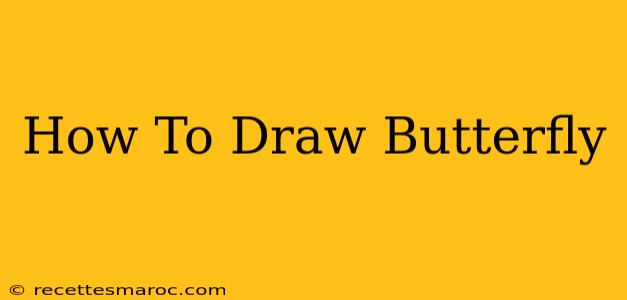Butterflies, with their vibrant wings and graceful flight, are a popular subject for artists of all skill levels. This guide will walk you through the process of drawing a butterfly, from simple shapes to intricate details, making it accessible even for complete beginners. Whether you're looking to create a realistic representation or a more stylized design, you'll find this tutorial helpful. Let's learn how to draw a butterfly!
Getting Started: Materials and Basic Shapes
Before we begin, gather your materials. You'll need:
- Paper: Any drawing paper will do, but smoother paper is generally easier for beginners.
- Pencil: A standard HB pencil is perfect for sketching.
- Eraser: A good eraser is essential for correcting mistakes.
- Colored pencils, crayons, or markers (optional): To add color and bring your butterfly to life.
Now, let's start with the basic shapes:
- The Body: Begin by drawing a long, thin oval for the butterfly's body. Think of it as a slightly elongated raindrop.
- The Wings: Draw two slightly overlapping circles on either side of the body. These will form the basis of the butterfly's wings. Don't worry about making them perfect; slight imperfections add character.
Refining the Butterfly's Shape
Now that we have the basic shapes, let's refine them to create a more realistic butterfly:
- Wing Shapes: Refine the circles into more wing-like shapes. You can make them slightly pointed at the tips, or add curves to create a more unique look. Experiment! There's no single "correct" way to draw a butterfly's wings.
- Antennae: Add two long, thin antennae extending from the head end of the body. These can be straight or slightly curved.
- Details: Add subtle curves and indentations to the wings to make them more lifelike. You can add a slight curve to the edges of the wings to give them a more organic feel.
Adding Detail and Texture
This is where your butterfly will really come to life. Let's add some intricate details:
- Patterns: Butterflies are known for their beautiful wing patterns. Use your pencil to lightly sketch various patterns on the wings. You can create symmetrical patterns, or opt for a more asymmetrical, natural look. Think about using circles, dots, lines, and other simple shapes to build complexity.
- Veins: Add delicate lines running through the wings to represent the veins. These add realism and texture. Start by drawing a few larger veins, then adding smaller ones branching out from them.
- Legs: Don't forget the legs! Draw six thin legs extending from the underside of the body.
Coloring Your Butterfly (Optional)
Once you're happy with your pencil sketch, you can add color. Experiment with different color combinations. Remember that the color of the butterfly will strongly influence the overall impression of the image.
- Layering: Use light layers of color, gradually building up intensity. This gives a more realistic effect than applying heavy color in one go.
- Blending: Blend the colors smoothly to avoid harsh lines.
Tips for Success
- Practice Makes Perfect: Don't be discouraged if your first attempt isn't perfect. Keep practicing, and you'll gradually improve your skills.
- Reference Images: Look at photos of real butterflies for inspiration and to guide your drawing. Observing the details is crucial.
- Experiment: Don't be afraid to experiment with different styles and techniques.
Conclusion: Your Butterfly Masterpiece
You've now learned how to draw a butterfly, from basic shapes to intricate details. Remember that the process is just as important as the final result. Enjoy the process of creation, and don't be afraid to let your creativity flow. With a little practice and patience, you'll be drawing beautiful butterflies in no time! Now go create your own amazing butterfly art! Share your creations and tag us—we'd love to see them!

